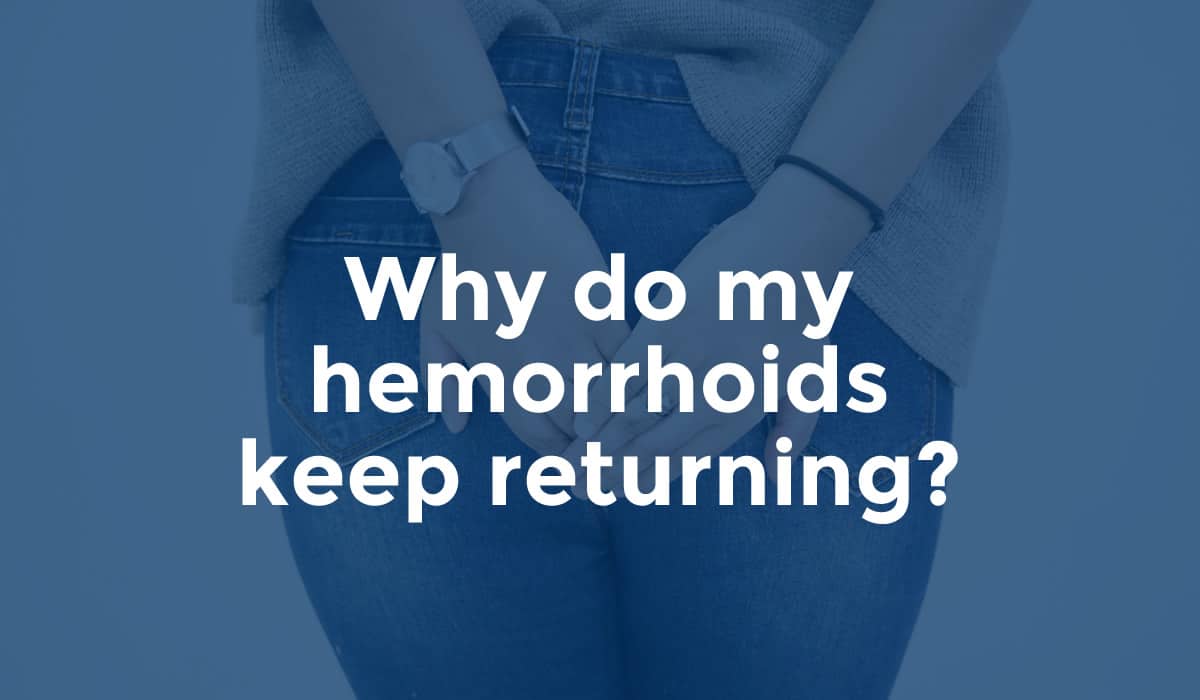You’ve tried everything to get rid of your hemorrhoids: diet changes, lifestyle modifications, home remedies, and topical medication. But nothing seems to last. Your hemorrhoids keep returning. And you don’t know why.
Thankfully, there is a long-term solution for recurring hemorrhoids. It’s called hemorrhoid banding. This procedure can improve your quality of life by permanently shrinking hemorrhoids.
This article will first discuss what hemorrhoids are. We’ll highlight the differences between internal hemorrhoids and external hemorrhoids. We’ll then explore why you may experience recurring hemorrhoids. Lastly, we’ll discuss treatments for hemorrhoid removal, including hemorrhoid banding.
What Are Hemorrhoids?
Hemorrhoids are swollen blood vessels in the rectum or anus. We all have these blood vessels, but we call them hemorrhoids when they become inflamed. You may experience hemorrhoids when the veins in your rectum or anus swell under pressure.
There are 2 types of hemorrhoids: internal hemorrhoids and external hemorrhoids.
Internal Hemorrhoids
Internal hemorrhoids occur inside the rectum. Usually, these hemorrhoids are only visible during a colonoscopy or anoscopy. But in more severe cases, they may prolapse and protrude outside the anus.
The rectum contains few pain fibers, so internal hemorrhoids may not hurt. Internal hemorrhoids may cause symptoms, including:
- Rectal bleeding
- Anal itching
- Stool leakage
- Swelling, fullness, and pressure
External Hemorrhoids
External hemorrhoids occur under the skin around the anus. They may look like swollen lumps. Symptoms of external hemorrhoids include:
- Pain
- Rectal bleeding
- Anal itching
- Anal swelling
Why Your Hemorrhoids Keep Returning
You may experience recurring hemorrhoids due to diet and lifestyle choices. This can result in increased pressure on the veins in your rectum and anus.
Causes of hemorrhoids include:
- Constipation
- Diarrhea
- Excess weight
- Prolonged sitting
- Heavy lifting
- Pregnancy
Topical medications may provide temporary relief from hemorrhoids. This includes creams, ointments, and suppositories. But these medications won’t prevent recurring hemorrhoids. This is because they only treat your symptoms.
If you want to find relief from hemorrhoids, you need to treat the cause. Making the following lifestyle changes may help you get rid of hemorrhoids:
- Eating more fiber
- Drinking plenty of fluids
- Avoiding prolonged sitting
- Avoiding straining
But if these treatments don’t work, you may benefit from hemorrhoid removal, either through surgery or hemorrhoid banding. Hemorrhoid banding is a minimally invasive, typically painless, long-term solution that can remove your hemorrhoids for good.
Treatments for Hemorrhoid Removal
Both non-surgical and surgical procedures can remove hemorrhoids. I offer hemorrhoid banding at my gastroenterology office in San Antonio, TX. We’ll discuss the treatments for hemorrhoid removal below.
Hemorrhoid Banding
Hemorrhoid banding is a non-surgical procedure that can permanently remove internal hemorrhoids. It is not used for EXTERNAL hemorrhoids. This procedure works by placing a rubber band around the hemorrhoid base, which cuts off its blood supply.
The lack of blood flow causes the hemorrhoid to shrivel up and fall off. Once the hemorrhoid falls off, scar tissue takes its place. This prevents any other veins from bulging into the anal canal. This means no more hemorrhoids.
Banding your hemorrhoids takes less than 5 minutes. You’ll be in and out of my office before you know it. Banding causes little to no pain in most people since there are no nerves at the hemorrhoid base. Some patients do experience pain and discomfort for a day or so afterward, so I always offer pain medication to have at home as well.
This procedure involves no anesthesia or downtime. You can immediately resume your daily activities as usual. I only ask that you avoid strenuous physical activity for 24 hours.
In rare cases, you may experience side effects of hemorrhoid banding such as:
- Infection
- Rectal bleeding
- Pain
- Recurrence of hemorrhoids
Hemorrhoid Surgery
A hemorrhoidectomy is a surgical procedure that can remove both internal and external hemorrhoids. This procedure occurs while you are under anesthesia. This is the treatment of choice for EXTERNAL hemorrhoids as those cannot be banded.
During a hemorrhoidectomy, the surgeon makes surgical incisions around the hemorrhoid. First, the swollen veins are tied to prevent bleeding. Then the surgeon removes the hemorrhoid. Your incision may remain open after the procedure to allow for healing. In some cases, the surgeon may stitch the wound.
You will experience pain after your hemorrhoid surgery. But pain medication may help.
Because a hemorrhoidectomy is a surgical procedure, you have a risk of developing medical complications. But complications are not common.
Risks of hemorrhoid surgery may include:
- Bleeding
- Reaction to the anesthesia
- Fecal impaction
- Incontinence
- Infection
- Narrowing of the anal canal (stricture)
- Anal fistula
- Rectal prolapse
- Recurrence of hemorrhoids
Hemorrhoid Banding in San Antonio, TX
If you experience recurring hemorrhoids, it’s a sign that something needs to change. Topical medication can provide short-term treatment by reducing your symptoms. But if you want lasting relief, you need to treat the cause of your hemorrhoids. This means changing those lifestyle habits that caused them to swell.
Hemorrhoid banding can cure your hemorrhoids by getting to the root of your problem. This means you no longer need to experience:
- Pain
- Stool leakage
- Anal itching
- Rectal bleeding
Hemorrhoid banding is a non-surgical procedure that is typically painless, fast, and has minimal risks compared to surgery.
If you want to get rid of your hemorrhoids for good in San Antonio, you can make an appointment online or call our office at 210-615-8303 to discuss the best treatment solution for you.






